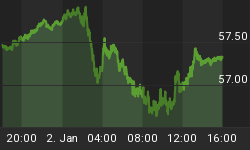The good news is:
• Several indices including the Russell 2000 (R2K), Dow Jones Transportsand S&P Mid cap hit all time highs last week.
Short term
The first chart covers the period from early October with dashed vertical lines on the 1st trading day of each month.
The NASDAQ new high indicator ( OTC NH), shown in green is a 10% trend (19 day EMA) of NASDAQ new highs, the NASDAQ composite (OTC) is shown in red.
The indicator moved mostly upward last week including Thursday and Friday which were both down days for the index.
The value of the indicator is 145 so more than 145 NASDAQ new highs will keep the indicator moving upward.

Net Field Trend (NFT) is an indicator developed by Joseph E. Granville and presented in his 1976 strategy book. The indicator looks for a pattern of progressively higher highs and higher lows or lower highs and lower lows in On Balance Volume (OBV) of the component issues of an index. The indicator is calculated by subtracting the percentage of issues with a negative trend from those with a positive trend.
The chart below shows the S&P mid cap index in red and NFT of its component issues in blue. The indicator went negative the day after the index hit an all time high. NFT's of both the S&P 500 (SPX) and R2K are also negative.

Intermediate term
Summation indices (SI) are running totals of oscillator values. When the oscillator is above 0 the SI rises and when it is below 0 the SI falls. Direction, not level is where these indicators are most valuable.
The chart below covers the period from October through last Friday showing the OTC in red and SI's calculated from NASDAQ advancing - declining issues, new highs - new lows and upside - downside volume.
The SI's are moving modestly upward.

The next chart shows the OTC in red and momentum of NASDAQ downside volume on an inverted Y axis in blue, it covers the period from October through last Friday.
As of Friday this indicator turned downward, it is too soon to know if it is a change in direction, but, if it is, it will be the second progressively lower high, not good.

Seasonality
Next week includes the 4th - 8th trading days of March during the 2nd year of the Presidential Cycle. There has been nothing remarkable about the period.
March
The first chart below shows the average performance for the OTC in March. The black line is the average of March for all years 1963 to 2005. The blue line is average of March during the 2nd year of the Presidential Cycle during the same period.
The number of trading days varies, but the average month has 21 trading days so the chart is made up of the first 11 trading days and the last 10 (the solid vertical black line indicates the cut off). In years when there were more than 21 trading days, one or more days in the middle were omitted and in years when there were less than 21 trading days, one or more in the middle were counted twice.

The next chart is similar to the one above except is shows the SPX using data from 1928 to 2005.

Conclusion
The indicators are directionless with some pointing modestly upward while others are pointing modestly downward and there is little seasonal bias to next week. Last week had a modestly positive seasonal bias and ended flat implying a modest relative weakness.
I expect the major indices to be lower on Friday March 10 than they were on Friday March 3.
Last week the major indices were mixed so I am calling last weeks positive forecast a tie.
This report is free to anyone who wants it, so please tell your friends. They can sign up at: http://alphaim.net/signup.html. If it is not for you, reply with REMOVE in the subject line. Gordon Harms produces a Power Point for our local timing group, you can get a copy of that at: http://www.stockmarket-ta.com/.
There are several new items on the Alpha web site that might interest you, including a report on the 4 year Presidential Cycle (under Alpha Research Reports) and Alpha's latest rankings in Money Manager Review and Nelson's Worlds Best Money Managers (in case you don't get that far, we are ranked 1st for the past year by both agencies). All of that can be accessed at: http://alphaim.net/newsletter.html.
















